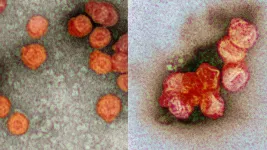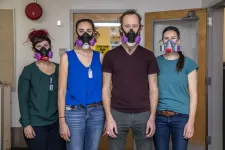(Press-News.org) Researchers have developed a computerized adaptive screener to identify youth at risk for attempting suicide. The screener, called the computerized adaptive screen for suicidal youth (CASSY), consists of 11 questions on average and correctly identified 82.4% of youth who went on to attempt suicide in the three months following screening. The results suggest this screener could serve as an easy-to-use way for providers to detect youth suicide risk in emergency department settings. The findings, funded by the National Institute of Mental Health (NIMH), part of the National Institutes of Health, appear in the journal JAMA Psychiatry.
"No young person should die by suicide, which is why we have made bending the curve in suicide rates a priority area of research for our institute," said Joshua A. Gordon, M.D., Ph.D., director of NIMH. "The CASSY screener represents an important advance in identifying those adolescents who are at risk for suicide, so they can be connected with the critical support services they need."
Suicide rates for adolescents have risen over the past two decades. In 2019, 1,580 adolescents between the ages of 12 and 17 died by suicide, which is a rate of 6.3 per 100,000, according to data from the Centers for Disease Control and Prevention. Since approximately 40% of adolescents who die by suicide have been treated for a mental health concern, it is important to screen broadly for suicide risk to help ensure at-risk youth are not missed.
Emergency departments are a common place where youth access emergency care, suggesting this environment is an optimal one in which to implement universal screening for suicide risk. Challenges to this type of implementation include the time and budgetary restrictions many emergency departments face. A suicide screener that can quickly and accurately identify suicide risk would help providers implement universal screening in these settings.
While there are currently brief suicide questionnaires that detect suicide risk, these screeners often have only moderate sensitivity (the ability of a test to correctly identify people with the targeted condition) or specificity (the ability of a test to correctly identify people without the targeted condition). The new screener uses an adaptive approach which offers a chance to improve the sensitivity of screening tools, as it uses a person's initial responses to help vary and personalize the later questions--thus the screener "adapts" to try to best fit each person who takes it.
In the first phase of the study, led by Cheryl King, Ph.D., a professor of psychiatry at the University of Michigan, Ann Arbor, researchers recruited youth between the ages of 12 and 17 in collaboration with 13 emergency departments who are part of the U.S. Pediatric Emergency Care Applied Research Network (PECARN). Youth who were admitted to an emergency department at the study sites during randomly selected shifts completed self-report questionnaires assessing suicide ideation and rumination; history of suicide attempts; self-injury; depression; hopelessness; alcohol and drug misuse; family, school, and social connectedness; physical and sexual abuse; and other factors that have been found to be related to suicide risk. Youth and their parents then received follow-up calls three months after this initial screening to learn if the youth had tried to end their life in the intervening months.
The researchers used these data to create the CASSY. In the second phase of the study, the researchers tested the ability of CASSY to predict suicide risk in a new set of youth, aged 12 to17, who presented to 14 PECARN emergency departments and one Indian Health Service emergency department. Youth completed the CASSY as well as a subset of the questionnaires given to participants in the first phase of the study. Similarly, to phase 1 of the study, youth and their parents were contacted three months after completing the initial screeners to learn whether the youth had tried to end their life in the past three months.
When researchers looked at the data from the second phase of the study, they found 6% of participants had attempted suicide in the three months between initial screening and follow-up. CASSY correctly identified 82.4% of youth who had attempted suicide in the three months after screening and 72.5% of people who did not attempt suicide in the three months after screening.
"As we strive to prevent more youth suicides, identifying as many youths at risk as possible should be prioritized. Yet, emergency departments are often challenged by limited resources for mental health follow-up, such that universal screening becomes more feasible if the screen's false positive rate is relatively low," said King. "Because CASSY is dimensional, it offers the ability for hospitals to alter the sensitivity and specificity of the screen, balancing the false positive and negative rates to best fit each specific emergency department's resource needs."
The study had some limitations. For example, the data were collected in emergency departments connected to academic institutions and may not represent all emergency departments. In addition, a significant portion of adolescents who were approached to participate in initial screening declined. Of those who did participate in the initial screening, not all responded to contact attempts at the three-month follow-up timepoint.
Despite these limitations, the findings suggest that CASSY provides a valuable tool for identifying youth at risk for suicide in the months following screening and may help emergency personnel identify individuals who are at need of increased support and suicide prevention services.
The researchers note that moving forward, it will be important to develop triage recommendations for CASSY and collaborate with emergency departments to identify optimal screening implementation strategies.
INFORMATION:
If you or someone you know is in crisis and needs immediate help, call the National Suicide Prevention Lifeline at 1-800-273-TALK (8255).
Learn more about ways you can help someone who might be at risk for self-harm.
Reference:
King, C., Brent, D., Grupp-Phelan, J., Casper, C., Dean, J. M., Chernick, L. S., Fein, J. A., Mahabee-Gittens, E. M., Patel, S. J., Mistry, R. D., Duffy, S., Melzer-Lange, M., Rogers, A., Cohen, D. M., Keller, A., Shenoi, R., Hickey, R. W., Rea, M., Cwik, M., Page, K., McGuire, T. C., Wang, J., Gibbons, R., and Pediatric Emergency Care Applied Research Network. (2021). Prospective development and validation of the computerized adaptive screen for suicidal youth. JAMA Psychiatry
About the National Institute of Mental Health (NIMH): The mission of the NIMH is to transform the understanding and treatment of mental illnesses through basic and clinical research, paving the way for prevention, recovery, and cure. For more information, visit the NIMH website.
About the National Institutes of Health (NIH): NIH, the nation's medical research agency, includes 27 Institutes and Centers and is a component of the U.S. Department of Health and Human Services. NIH is the primary federal agency conducting and supporting basic, clinical, and translational medical research, and is investigating the causes, treatments, and cures for both common and rare diseases. For more information about NIH and its programs, visit the NIH website.
NIH...Turning Discovery Into Health®
Today, neuroscience and robotics are developing hand in hand. Mikhail Lebedev, Academic Supervisor at HSE University's Centre for Bioelectric Interfaces, spoke about how studying the brain inspires the development of robots.
Robots are interesting to neuroscience and neuroscience is interesting to robots - this is what the article 'Neuroengineering challenges of fusing robotics and neuroscience' was about in the journal Science Robotics. Such collaborative development contributes to progress in both fields, bringing us closer to developing more advanced android robots and a deeper understanding ...
Among the many avenues that viruses can use to infect humans, drinking water may pose only a tiny risk for spreading certain viruses like the novel coronavirus. However, in cases where there is unauthorized wastewater disposal or other events of inadvertent mixing of wastewater with water sources, the possibility of transmission through drinking water remains unknown.
Using a surrogate of the coronavirus that only infects bacteria, researchers at Texas A&M University have now presented strong evidence that existing water purification plants can easily reduce vast quantities of the virus thereby protecting our household water from such contagions. In particular, the researchers showed that the water purification step called coagulation could alone get rid of 99.999% of ...
The economic value of insect pollinators was $34 billion in the U.S. in 2012, much higher than previously thought, according to researchers at the University of Pittsburgh and Penn State University. The team also found that areas that are economically most reliant on insect pollinators are the same areas where pollinator habitat and forage quality are poor.
"Pollinators like bees play an extremely important role in agriculture," explained senior author Vikas Khanna, Wellington C. Carl Faculty Fellow and associate professor of civil and environmental engineering at Pitt's Swanson School of Engineering. "The insects that pollinate farmers' crops underpin our ecosystem biodiversity and function, ...
BOSTON - Although abnormal blood clotting has been identified as one of the primary causes of death from COVID-19, early treatment in an intensive care unit (ICU) with therapeutic anticoagulation (anti-clotting) for adults who are critically ill with COVID-19 does not appear to improve chances of survival, and could do more harm than good by increasing the risk for major bleeding, a multicenter research group cautions.
"In patients critically ill with COVID-19, therapeutic dose anticoagulation started early in the ICU stay was not associated with improved survival,"says Hanny Al-Samkari, MD, an investigator in the Division of Hematology/Oncology at Massachusetts General Hospital (MGH) and lead author ...
Studies examining the effectiveness of treatments for COVID-19 often do not include the very populations hardest hit by the disease, according to a new review by University of Chicago Medicine researchers.
The findings, based on an analysis of all US COVID-19 treatment trials registered on ClinicalTrials.gov, were published Jan. 27 in the Journal of General Internal Medicine.
"This study highlights the blind spot in how clinical trials are done in the United States," said senior author Neda Laiteerapong, MD, MS, a general internist and associate director of the Center for Chronic Disease Research and Policy at the University of Chicago. "Researchers, hospitals and pharmaceutical ...
UPTON, NY - Hundreds of naturally occurring specialty fatty acids (building blocks of oils) have potential for use as raw materials for making lubricants, plastics, pharmaceuticals, and more--if they could be produced at large scale by crop plants. But attempts to put genes for making these specialty building blocks into crops have had the opposite effect: Seeds from plants with genes added to make specialty fatty acids accumulated dramatically less oil. No one knew why.
Now two teams of biochemists working on separate aspects of oil synthesis at the U.S. Department of Energy's Brookhaven National Laboratory have converged to discover the mechanism behind the oil-production slowdown. As described in the journal Plant Physiology, they crossbred model plants and conducted detailed ...
TAMPA, Fla. -- The prognosis of ovarian cancer is poor, with an estimated five-year survival of only 40% for advanced disease, the stage at which most ovarian carcinomas are diagnosed. These poor outcomes are partly due to the lack of effective therapies for advanced disease and recurrence. Immunotherapies hold promise for many types of cancer; however, studies have shown that patients with ovarian cancer do not have strong responses to existing drugs. In a new article published in Nature, Moffitt Cancer Center researchers demonstrate why some ...
There is an impassioned debate taking place in medicine on whether race-based considerations should be a factor in research, diagnoses, or treatments. Those on one side assert that race should be ignored entirely because it is a societal construct with no biological basis, and accordingly many hospitals are abandoning long-established "race corrections" in medical algorithms and diagnostics. Others, like Meghan McGarry, MD, MS, assistant professor of pediatrics at UC San Francisco, say that we can't completely ignore race, precisely because science is rarely free of societal influence - the structural inequality ...
Since element 99 - einsteinium - was discovered in 1952 at the Department of Energy's Lawrence Berkeley National Laboratory (Berkeley Lab) from the debris of the first hydrogen bomb, scientists have performed very few experiments with it because it is so hard to create and is exceptionally radioactive. A team of Berkeley Lab chemists has overcome these obstacles to report the first study characterizing some of its properties, opening the door to a better understanding of the remaining transuranic elements of the actinide series.
Published in the journal Nature, the study, "Structural and Spectroscopic Characterization of an Einsteinium Complex," was co-led by Berkeley Lab scientist Rebecca Abergel and Los ...
The Arctic Ocean was covered by up to 900 m thick shelf ice and was filled entirely with freshwater at least twice in the last 150,000 years. This surprising finding, reported in the latest issue of the journal Nature, is the result of long-term research by scientists from the Alfred Wegener Institute and the MARUM. With a detailed analysis of the composition of marine deposits, the scientists could demonstrate that the Arctic Ocean as well as the Nordic Seas did not contain sea-salt in at least two glacial periods. Instead, these oceans were filled with large amounts of freshwater under a thick ice shield. This water could then be released into the North Atlantic in very short periods of time. Such sudden freshwater inputs could explain rapid climate oscillations for which no satisfying ...




